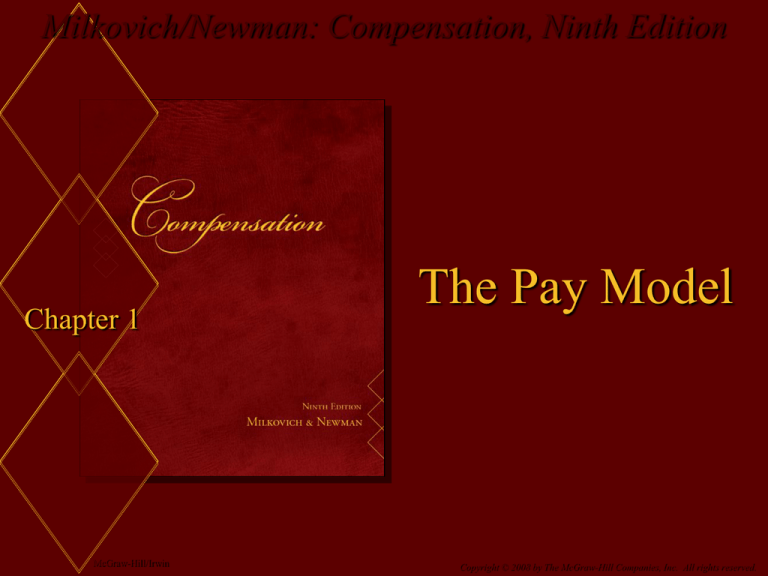
Milkovich/Newman: Compensation, Ninth Edition
Chapter 1
McGraw-Hill/Irwin
The Pay Model
Copyright © 2008 by The McGraw-Hill Companies, Inc. All rights reserved.
Contrasting Perspectives of
Compensation
Society’s
Views
Stockholders’
Views
Employees’
Views
Managers’
Views
1-2
Compensation: Definition
Employees
–
–
–
–
Major source of financial security
Return in an exchange between employer and themselves
Entitlement for being an employee of the company
Reward for a job well done
1-3
Compensation: Definition (cont.)
Society
– Pay as a measure of justice
Gender pay gap in U.S., after adjusting for differences in
education, experience, occupation, has narrowed from 36
percent in 1980 to 13 percent in 2006
– Benefits as a reflection of justice in society
~46m Americans do not have health insurance (16% of
population)
Proportion of Americans w/ private insurance 67.5% in 2007
– Job losses (or gains) attributed to differences in
compensation (see Ex. 1.1)
– Belief that pay increases lead to price increases
1-4
Exhibit 1.1 update: Hourly Compensation
Costs for Production Workers (2007 data)
United States
$24.59
Brazil
5.96
Canada
28.91
Mexico
2.92
Austria
35.33
Belgium
35.45
Czech Republic
8.20
($2.83 in 2000)
Denmark
42.29
Finland
34.18
France
28.57
5.78
Germany
37.66
Japan
19.75
Hungary
7.91
South Korea
16.02
Australia
30.17
Hong Kong
($8.23 in 2000)
($2.79 in 2000)
Ireland
29.04
Singapore
8.35
Italy
28.23
Sri Lanka
0.61*
Netherlands
34.07
Norway
48.56
Poland
6.17
Portugal
8.27
(comparable to China?)
Taiwan
6.58
Source: U.S. Department of Labor, Bureau of Labor
Statistics, January 2009.
Spain
20.98
Sweden
36.03
Switzerland
32.88
United Kingdom
29.73
Hourly compensation costs include (1) hourly direct pay and (2)
employer social insurance expenditures and other labor
1-5
taxes.
Compensation: Definition (cont.)
Stockholders
– Linking executive pay to company performance theoretically
increases stockholders' returns (see Ex. 1.2)
Managers
– A major expense (labor expense can account for 50+% of
total costs)
– Used to influence employee behaviors and to improve the
organization's performance (see Ex. 1.3)
Grocery store clerk pay (2005):
–
–
–
–
–
Industry average: $12.28/hr
Costco:
$16
Whole Foods
$12.50
Sam’s Club
$12
Wal-Mart
$9.68
Labor costs as % of total costs for grocery stores historically 15-18%;
today norm is 9-12%; warehouse stores 4-6%; Whole Foods 25%
1-6
Labor Costs as a Percentage of Revenues,
Airline Industry
(8e)
1-7
What Is Compensation?
Compensation refers to all
forms of financial returns
and tangible services and
benefits employees
receive as part of an
employment relationship
1-8
Exhibit 1.4: Total Returns for Work
1-9
Forms Of Pay
Relational returns
– Psychological in nature
Total compensation
– Cash Compensation/ transactional
Base wages
– Difference between wage and salary
Merit pay/cost-of-living adjustments
– Merit increases – given in recognition of past work behavior –
adjustments to base
– Cost-of-living adjustments –same increases to everyone,
regardless of performance
1-10
Forms Of Pay (cont.)
– Cash Compensation/ transactional (cont.)
Incentives/ Variable pay – tie pay increases directly to
performance
– Does not increase base wage; must be reearned each pay period
– Potential size generally known beforehand
– Long-term (stock options), and short-term
– Benefits
Income protection (some are legally required)
Work/life balance (includes pay for time not worked)
Allowances (e.g., expatriates)
1-11
Exhibit 1.5: THE PAY MODEL
POLICIES
ALIGNMENT
COMPETITIVENESS
CONTRIBUTORS
TECHNIQUES
Work
Descriptions Evaluation/ INTERNAL
analysis
certification STRUCTURE
Market
Surveys
definitions
Seniority
based
Policy
lines
Performance
based
Merit
guidelines
OBJECTIVES
PAY
STRUCTURE
EFFICIENCY
• Performance
• Quality
• Customers
• Stockholders
• Costs
INCENTIVE
PROGRAMS
FAIRNESS
COMPLIANCE
MANAGEMENT
Costs
Communication
Change
EVALUATION
1-12
Exhibit 1.6: Pay Objectives at Medtronic
and Whole Foods
1-13
Four Policy Choices
Internal alignment
– Focus - Comparisons among jobs or skill levels inside
a single organization
– Pay relationships within an organization affect
employee decisions to:
Stay with the organization
Become more flexible by investing in additional training
Seek greater responsibility
External
competitiveness
– Focus - Compensation relationships external to the
organization: comparison with competitors
– Pay is ‘market driven’
1-14
Four Policy Choices (cont.)
External competitiveness (cont.)
– Effects of decisions regarding how much and what forms:
To ensure that pay is sufficient to attract and retain employees
To control labor costs to ensure competitive pricing of products/
services
Employee contributions
– Focus - Relative emphasis placed on employee performance
Performance based pay affects fairness
Management
– Focus - Policies ensuring the right people get the right pay
for achieving the right objectives in the right way
1-15
Listening to HR’s Critics
Quantify people-management results into dollars
– Productivity of workforce
– Cost of vacant position
– Cost of keeping bad manager
– Dollar impact of hiring and keeping top performers vs.
average ones in mission-critical jobs
Adopt “fact-based” decision-making
– Not “I think” or “I believe” but “I know” re: cause and
effect
Causes of turnover
What motivates workers to produce more
Which HR actions can turn business unit around
Source: Workforce Management, 7/31/06
1-16
Evidence-based HR Decision-making
Assumption that correlation implies causation pervades
decision making in human resources and pay plan design.
– Inferential issue: "The CEO drank Wild Turkey; the company
performed well; ergo, all CEOs should drink more Wild Turkey.
The company uses individual incentives; the company performs
well; ergo all companies should use more incentives.“
"The first step is to know what the evidence says. Know the
research literature that pertains to your business. Diffusion
and persistence do not prove effectiveness.“
“The goal is to transform human resources into the R&D
department for the human system, which is the most
important system in almost all organizations.”
– "In R&D, you go into the laboratory, you experiment and you keep
up with the research that others do. Can you imagine walking into
the R&D lab at a pharmaceutical company, asking the chief
chemist about an important new study and having him respond that
they don't keep up with the literature in chemistry?“
Jeffrey Pfeffer, Stanford University, in Workforce Management, 11/3/08
1-17





